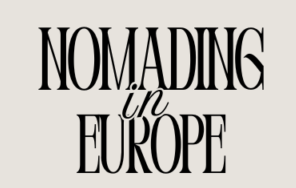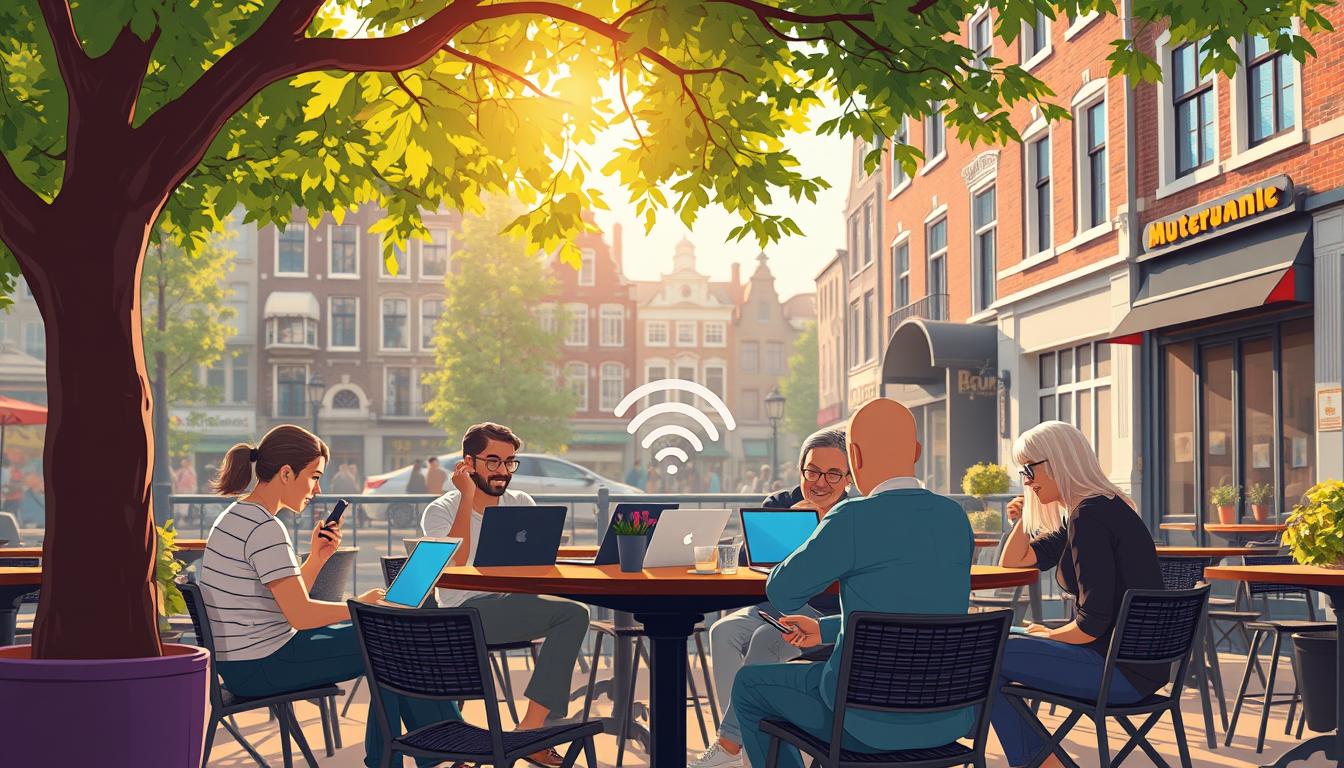Have you ever wondered how digital nomads stay connected while exploring the Netherlands? With the rise of remote work, finding reliable ways to stay online is more crucial than ever. Whether you’re working from a cozy café in Amsterdam or a bustling coworking space in Rotterdam, having a dependable mobile hotspot can make all the difference.
This guide is designed to help you navigate the vibrant digital nomad scene in the Netherlands. From top-rated devices like the Franklin Wireless JEXtream RG2100 5G to essential tips on choosing the right hotspot plan, we’ve got you covered. Plus, we’ll dive into the best events and communities where you can connect with like-minded professionals.
Battery life and connectivity are key factors for any nomad on the go. With insights from trusted sources like PCMag and NYT Wirecutter, this guide ensures you’re equipped with the knowledge to thrive in a mobile work environment. Ready to explore? Let’s get started.
Contents
- 1 Exploring the Digital Nomad Lifestyle in Europe
- 2 The Ultimate Guide to Networking Hotspots
- 3 Navigating Coworking Spaces in the Netherlands
- 4 Cost of Living Insights for Digital Nomads
- 5 Visa Requirements and Remote Work Regulations in Europe
- 6 Best Cities for Remote Work in the Netherlands
- 7 Maximizing Internet Speed and Connectivity
- 8 Accommodation Options for the Digital Nomad
- 9 Staying Safe: Local Safety and Cybersecurity Tips
- 10 Networking Opportunities and Community Events
- 11 Recommended Apps, Tools, and Online Communities
- 12 Understanding Mobile Hotspot Features and Performance
- 13 Final Thoughts on Embracing the Nomad Journey
Exploring the Digital Nomad Lifestyle in Europe
What does it truly mean to live as a digital nomad in Europe? This lifestyle combines work and travel, allowing professionals to explore new cultures while staying productive. Europe’s diverse cities, affordable living costs, and reliable internet make it a top choice for remote workers.
Flexible work environments are key to this lifestyle. Cities like Amsterdam and Berlin are packed with coworking spaces designed for productivity. These spaces offer high-speed internet, ergonomic furniture, and networking opportunities. They’re perfect for balancing work and travel.
Your device setup is crucial for efficiency. A reliable laptop, a backup phone, and portable Wi-Fi ensure you’re always connected. Many nomads use eSIMs or local SIM cards for seamless transitions between countries. A good plan for data usage helps avoid unexpected costs.
Balancing work and travel requires discipline. Some nomads prefer structured schedules, while others embrace flexibility. Tools like Google Drive and offline maps help maintain productivity, even in areas with limited connectivity.
Living costs and visa regulations vary across Europe. Countries like Portugal and Estonia offer digital nomad visas, simplifying residency requirements. Researching local costs, such as accommodation and transportation, ensures a smooth transition.
Here are some practical tips for thriving as a digital nomad in Europe:
- Choose coworking spaces with reliable internet and amenities.
- Invest in a portable device and backup phone for emergencies.
- Plan your data usage to avoid overages.
- Explore cities with affordable living costs, like Lisbon or Tallinn.
- Stay updated on visa requirements for seamless travel.
Europe’s blend of culture, affordability, and connectivity makes it an ideal destination for digital nomads. With the right tools and mindset, you can thrive in this exciting lifestyle.
The Ultimate Guide to Networking Hotspots
Reliable internet is the backbone of any successful remote work setup. For digital nomads, choosing the right tools for connectivity can make or break productivity. Whether you’re attending events or working on the go, a strong network ensures you stay connected.
Top-rated devices like the NETGEAR Nighthawk M6 Pro and Skyroam Solis X are game-changers. These devices support multiple connections and offer long battery life. According to PCMag and NYT Wirecutter, they perform exceptionally well on 5G networks, delivering fast speeds and low latency.
Choosing the right carrier is equally important. T-Mobile and Verizon offer unlimited data plans, ideal for heavy users. AT&T provides affordable options but may throttle speeds after a certain threshold. Always compare plans to find the best fit for your needs.
Here are some tips to maximize your network performance:
- Invest in a device that supports both 4G and 5G for flexibility.
- Monitor your data usage to avoid overages or throttling.
- Use eSIMs or local SIM cards for seamless transitions between countries.
- Opt for a phone plan that aligns with your usage patterns.
By selecting the right tools and carrier, you can ensure uninterrupted connectivity. This is especially crucial during events or when collaborating with teams. With the right setup, you’ll stay productive and connected, no matter where your journey takes you.
Finding the right coworking space in the Netherlands can transform your remote work experience. These spaces are designed to boost productivity while offering a sense of community. Whether you’re in Amsterdam, Rotterdam, or Utrecht, there’s a spot tailored to your needs.
Coworking spaces in the Netherlands are known for their reliable service and modern amenities. High-speed internet, ergonomic furniture, and meeting rooms are standard. Many also offer coffee bars, lounges, and event spaces to foster connections.

For digital nomads, battery life is crucial. Most coworking spaces provide ample charging stations and power outlets. This ensures your devices stay powered throughout the day, even when you’re away from your home office.
Cost-effective options are available in every major city. Monthly memberships range from €100 to €300, depending on location and amenities. Some spaces offer day passes or flexible plans for short-term stays.
Here’s how to make the most of coworking spaces:
- Choose a location close to public transport for easy access.
- Look for spaces with private meeting rooms for client calls.
- Take advantage of community events to expand your network.
- Use apps like Google Calendar to schedule your work sessions efficiently.
The Netherlands is leading the way in workspace connectivity. Many coworking spaces now offer 5G networks and advanced tech setups. This makes it easier than ever to stay connected and productive.
Whether you’re a freelancer or part of a remote team, coworking spaces in the Netherlands provide the perfect environment to thrive. With the right space, you can balance work and exploration seamlessly.
Cost of Living Insights for Digital Nomads
Managing expenses as a digital nomad in Europe requires careful planning and smart choices. From housing to coworking spaces, understanding the cost of living is essential for a seamless experience. Let’s break down the key factors to help you budget effectively.
Housing costs vary widely across Europe. In Amsterdam, a one-bedroom apartment averages €1,500 per month, while in Lisbon, it’s around €900. For nomads on a budget, cities like Zagreb or Belgrade offer affordable options, with rents starting at €500. Shared accommodations or short-term rentals can further reduce expenses.
Food and daily expenses also differ by location. In the Netherlands, a meal at a mid-range restaurant costs €15-20, while in Warsaw, it’s closer to €10. Grocery shopping and cooking at home can save you up to 30% on food costs. Public transport is another factor, with monthly passes ranging from €40 in Lisbon to €82 in Dubai.
Reliable internet is non-negotiable for remote work. Many coworking spaces in Europe offer high-speed connections, but investing in a Wi-Fi hotspot ensures connectivity on the go. Devices like the Skyroam Solis X provide dedicated ports for multiple connections, enhancing productivity.
Here are some tips to manage your budget effectively:
- Choose cities with lower living costs, such as Belgrade or Chiang Mai.
- Use apps like Numbeo to compare expenses across locations.
- Opt for coworking spaces with flexible memberships to save on workspace costs.
- Invest in a reliable Wi-Fi hotspot to avoid expensive data plans.
Balancing work and travel is easier when you plan your finances wisely. By understanding the cost of living and investing in the right tools, you can enjoy a high-quality life as a digital nomad in Europe.
Visa Requirements and Remote Work Regulations in Europe
Navigating visa requirements and remote work regulations in Europe can seem daunting, but it’s essential for digital nomads. Each country has its own rules, and staying compliant ensures a smooth experience. From income thresholds to processing times, understanding these details is key.
Countries like Croatia, Portugal, and Estonia offer digital nomad visas. These visas typically require proof of income, ranging from €2,870 to €4,500 per month. Processing times vary, with Croatia taking up to three months and Armenia around two. Planning ahead is crucial to avoid delays.
A reliable connection is vital for compliance. Many visas require proof of remote work, which depends on consistent internet access. A dedicated hotspot ensures you stay connected, even when transitioning between countries. Devices like the Skyroam Solis X offer fast speed and multiple connections, making them ideal for nomads.
Here are some tips to stay compliant:
- Research income requirements and processing times for your target country.
- Invest in a dedicated hotspot to maintain a stable connection.
- Prepare all necessary paperwork, including proof of income and employment.
- Leverage local digital nomad communities for support and advice.
Maintaining a reliable connection is not just about productivity—it’s about compliance. Whether you’re in Croatia or Cyprus, a fast speed ensures you meet visa requirements and keep your business running smoothly. With the right tools and preparation, you can thrive as a digital nomad in Europe.
Best Cities for Remote Work in the Netherlands
The Netherlands offers a unique blend of modern infrastructure and cultural charm, making it a top destination for remote workers. Whether you’re looking for bustling urban centers or serene university towns, this country has something for everyone. Let’s explore the best cities for remote work, focusing on coworking opportunities, connectivity, and quality of life.
Amsterdam is a standout choice for digital nomads. Known for its vibrant culture and reliable cell phone service, the city is packed with coworking spaces and cafes tailored for productivity. Many of these spaces offer smartphone-friendly setups, ensuring you stay connected wherever you go. Plus, Amsterdam’s central location makes it easy to explore Europe during your downtime.

Rotterdam is another excellent option. This city is a hub for innovation and sustainability, attracting startups and freelancers alike. With its affordable living costs and high-speed internet, Rotterdam is perfect for those seeking a balance between work and lifestyle. Look out for local deals on coworking memberships to maximize your budget.
Utrecht offers a more relaxed atmosphere, ideal for those who prefer a quieter environment. As a university town, it boasts excellent amenities and a strong sense of community. The city’s cell phone coverage is top-notch, ensuring seamless connectivity for remote work. Utrecht’s compact size also means everything is within walking distance.
Here’s a quick comparison of these cities:
- Amsterdam: Vibrant culture, reliable cell phone service, and numerous coworking spaces.
- Rotterdam: Affordable, innovative, and packed with deals for digital nomads.
- Utrecht: Relaxed, community-focused, and perfect for a quieter work environment.
When choosing the best option, consider your work style and lifestyle preferences. Each city offers unique advantages, from Amsterdam’s energy to Utrecht’s tranquility. With the right smartphone and connectivity tools, you can thrive in any of these locations.
The Netherlands continues to lead the way in remote work, offering a perfect blend of productivity and quality of life. Whether you’re in Amsterdam, Rotterdam, or Utrecht, you’ll find the resources and community you need to succeed.
Maximizing Internet Speed and Connectivity
Ensuring fast and reliable internet is a top priority for digital nomads working across the Netherlands. Whether you’re in a bustling city or a quiet café, optimizing your setup can make a world of difference. Here’s how to enhance your internet speed and maintain seamless connectivity.
Start by choosing the right feature-rich hotspot. Devices like the NETGEAR Nighthawk M6 Pro support dual-band Wi-Fi, offering faster speeds on the 5 GHz band. According to PCMag, staying within five feet of your hotspot ensures optimal performance, especially when using this frequency.
Managing your data cap is equally important. Many plans throttle speeds after a certain usage limit, even if they advertise unlimited data. Monitor your usage each month to avoid unexpected slowdowns. Tools like My Data Manager can help track consumption and keep you on track.
Advanced features like guest networks and dual-band support can boost your network’s reliability. For example, the Skyroam Solis X allows multiple connections, making it ideal for team collaborations. These features ensure you stay productive, even in busy environments.
Here are some actionable tips to maximize your internet speed:
- Use the 5 GHz band for faster speeds, especially in areas with minimal interference.
- Regularly update your hotspot and devices to maintain peak performance.
- Restart your hotspot periodically to reset network connections and resolve issues.
- Invest in a modern device with Wi-Fi 7 support for enhanced speed and capacity.
By leveraging these strategies and features, you can ensure a smooth and reliable internet experience. Whether you’re working from Amsterdam or Rotterdam, these tips will keep you connected and productive.
Accommodation Options for the Digital Nomad
Finding the perfect place to stay is a top priority for digital nomads in the Netherlands. Your choice of accommodation directly impacts your productivity and lifestyle. Whether you prefer hotels, hostels, or short-term rentals, each option offers unique advantages tailored to your needs.
Location plays a crucial role in ensuring access to high-speed internet and coworking facilities. Cities like Amsterdam and Rotterdam are packed with options that combine comfort and connectivity. For instance, Locke aparthotels in Amsterdam feature on-site coworking spaces and gyms, making them ideal for remote work.
When choosing accommodations, prioritize spaces with dedicated workspaces and robust connectivity. Platforms like Flatio and Selina offer fully furnished flats with high-speed internet, ensuring you stay productive. Many properties also include ergonomic furniture and meeting rooms, catering to your professional needs.
Short-term rentals are perfect for nomads who value flexibility. Platforms like Airbnb and Spotahome provide options with minimum stays of 30 days. However, be cautious of inconsistent internet speeds, as some listings may not meet your performance expectations.
Long-term rentals, on the other hand, offer stability and cost savings. Anyplace specializes in monthly rentals with gigabit-speed internet, available in cities like Amsterdam and Rotterdam. These properties often include extensive workspaces, webcams, and microphones, ensuring you’re always ready for virtual meetings.
Here are some tips to find the best accommodation:
- Choose locations close to coworking spaces and public transport for easy access.
- Verify internet speeds and connectivity features before booking.
- Negotiate deals with property owners for long-term stays to save on costs.
- Use platforms like Flatio and Selina for deposit-free, digital-ready homes.
By selecting the right accommodation, you can enhance your remote work experience in the Netherlands. Whether you’re in a bustling city or a quieter area, the right space ensures you stay connected and productive.
Staying Safe: Local Safety and Cybersecurity Tips
Staying safe while working remotely requires both physical and digital vigilance. As a digital nomad, you’re often in unfamiliar environments, making it essential to protect yourself both online and offline. Here’s how to ensure your safety while maintaining productivity.
Physical safety starts with awareness. Avoid displaying expensive devices in public, and always keep your belongings secure. In crowded areas, be mindful of pickpocketing, especially in major tourist destinations. Use a prepaid card for transactions to limit potential losses from theft.

Cybersecurity is equally important. Public Wi-Fi networks are often unsecured, exposing your data to risks like man-in-the-middle attacks. Always use a VPN to encrypt your internet traffic, ensuring your cell data remains private. Avoid accessing sensitive information, such as banking details, on public networks.
For secure video conferencing, use platforms with end-to-end encryption. Regularly update your devices and apps to patch vulnerabilities. Implement multi-factor authentication (MFA) for an added layer of security. This reduces the risk of unauthorized access to your accounts.
Here are some actionable tips to enhance your safety:
- Disable auto-connect features to avoid joining malicious networks.
- Use a local SIM card for encrypted cell coverage instead of relying on public Wi-Fi.
- Reset passwords before traveling to minimize the risk of account compromise.
- Install security apps to monitor and protect your devices.
By combining these physical and digital safety measures, you can work confidently in any location. Whether you’re in a bustling city or a quiet café, staying vigilant ensures a secure and productive remote work experience.
Networking Opportunities and Community Events
Building meaningful connections is a cornerstone of the digital nomad lifestyle. In the Netherlands, local events and meetups provide a platform to grow both personally and professionally. These gatherings are tailored to remote workers, offering a mix of social interaction and technological support.
Face-to-face interactions remain a powerful tool for professional growth. Events like the Amsterdam Digital Nomads Meetup and Rotterdam Remote Workers Social foster connections that go beyond online chats. These gatherings often feature workshops, panel discussions, and informal networking sessions.
Case studies show how effective device management enhances event experiences. For instance, using an mbp with a high-resolution screen ensures clear presentations and seamless collaboration. Attendees rate these events highly when technology supports their needs.
Curated event calendars, like those on Meetup.com, help nomads stay informed. These platforms list upcoming gatherings, making it easy to plan your schedule. Whether it’s a tech-focused workshop or a casual coffee meetup, there’s something for every person.
Here are some practical tips to maximize your experience:
- Prepare your devices, ensuring your mbp and screen are optimized for presentations.
- Engage in meaningful conversations, focusing on quality over quantity.
- Follow up with new contacts via email or LinkedIn to solidify connections.
- Use event apps to stay organized and track sessions that interest you.
By participating in these events, you can expand your network and gain valuable insights. The Netherlands offers a vibrant community for digital nomads, making it easier to thrive in this dynamic lifestyle.
Recommended Apps, Tools, and Online Communities
What tools can help digital nomads stay productive and connected while traveling? The right apps and resources are essential for managing work, travel, and social interactions. From task management to signal optimization, these tools ensure you’re always on top of your game.
Todoist is a top choice for task management. With a starting price of $4 per month, it helps you organize tasks and deadlines efficiently. Users rate it 5.0 for its simplicity and reliability. For team collaboration, Asana ($15/month) offers advanced features like project timelines and team dashboards.
When it comes to mobile productivity, Microsoft 365 ($6.99/month) is a versatile option. It includes Word, Excel, and Teams, ensuring seamless collaboration. Slack ($8.75/month) is another favorite, offering channels and direct messaging for real-time communication.
For community building, Disco stands out with its customizable platform. It allows creators to launch branded communities in minutes. Features like monetization options and robust analytics make it a powerful alternative to Facebook Groups. Users appreciate its focus on data security and privacy.
Here are some additional tools to enhance your digital nomad experience:
- Miro ($10/month): A visual collaboration tool for brainstorming and planning.
- Google Workspace ($6/month): Includes Gmail, Drive, and Docs for cloud-based work.
- Circle: A dedicated community platform with monetization options.
- Patreon: Ideal for creators looking to monetize their audience through subscriptions.
Strong signal management is crucial for remote work. Tools like NetSpot help analyze Wi-Fi performance, ensuring you’re always connected. Regularly updating your apps and devices also enhances performance and security.
Online communities like LinkedIn Groups and Mighty Networks provide networking opportunities. These platforms focus on professional growth and knowledge exchange. Whether you’re looking for industry-specific discussions or casual meetups, there’s a community for every person.
By leveraging these apps and tools, digital nomads can streamline their workflow and stay connected. Continuous updates and effective signal management are key to thriving in this dynamic lifestyle.
Understanding Mobile Hotspot Features and Performance
Understanding the technical features of mobile hotspots can significantly enhance your remote work experience. These devices are designed to provide reliable connectivity, but not all are created equal. To make the best choice, you need to evaluate key metrics like speed, range, and tethering capabilities.
Modern mobile hotspots support advanced -fi standards, ensuring faster speeds and better performance. Devices like the NETGEAR Nighthawk M6 Pro and Skyroam Solis X are top-rated for their ability to handle multiple connections. According to PCMag, these models excel in both urban and rural settings, offering speeds up to 1,000 Mbps in optimal conditions.
When choosing a hotspot, consider its range and how it performs in different environments. For example, the T-Mobile Inseego MiFi X PRO 5G supports up to 32 devices, making it ideal for team collaborations. Meanwhile, the Alcatel LINKZONE is more budget-friendly but offers speeds around 15–30 Mbps, suitable for lighter usage.
Here’s a step-by-step guide to evaluating hotspot features:
- Check the device’s supported -fi standards (e.g., Wi-Fi 6 or 5G).
- Evaluate its range and ability to maintain a stable connection in various locations.
- Look for tethering capabilities, allowing you to share your connection with multiple devices.
- Compare battery life, especially if you’re frequently on the move.
- Read reviews from trusted sources like PCMag and Wirecutter for performance benchmarks.
Expert advice suggests balancing technical performance with ease of use. For instance, the NETGEAR Nighthawk M6 5G offers advanced features but comes at a higher price point. On the other hand, the Huawei E5577-320 is more affordable but may lack some premium features.
By understanding these features, you can select a hotspot that meets your specific needs. Whether you prioritize speed, range, or tethering, the right device ensures you stay connected and productive wherever you go.
Final Thoughts on Embracing the Nomad Journey
Embracing the digital nomad lifestyle is about more than just travel—it’s a mindset. This guide has highlighted the importance of staying connected and building a supportive community. Whether you’re managing your data cap or choosing the right router, these tools are essential for success.
Case studies show that adaptability and preparation are key. By leveraging the right resources, you can overcome challenges and thrive. Don’t forget to download additional guides and join online communities for ongoing support.
Your journey as a digital nomad is unique. Use this guide as a roadmap to optimize your lifestyle and professional opportunities. With the right mindset and tools, you can turn challenges into stepping stones for growth.


